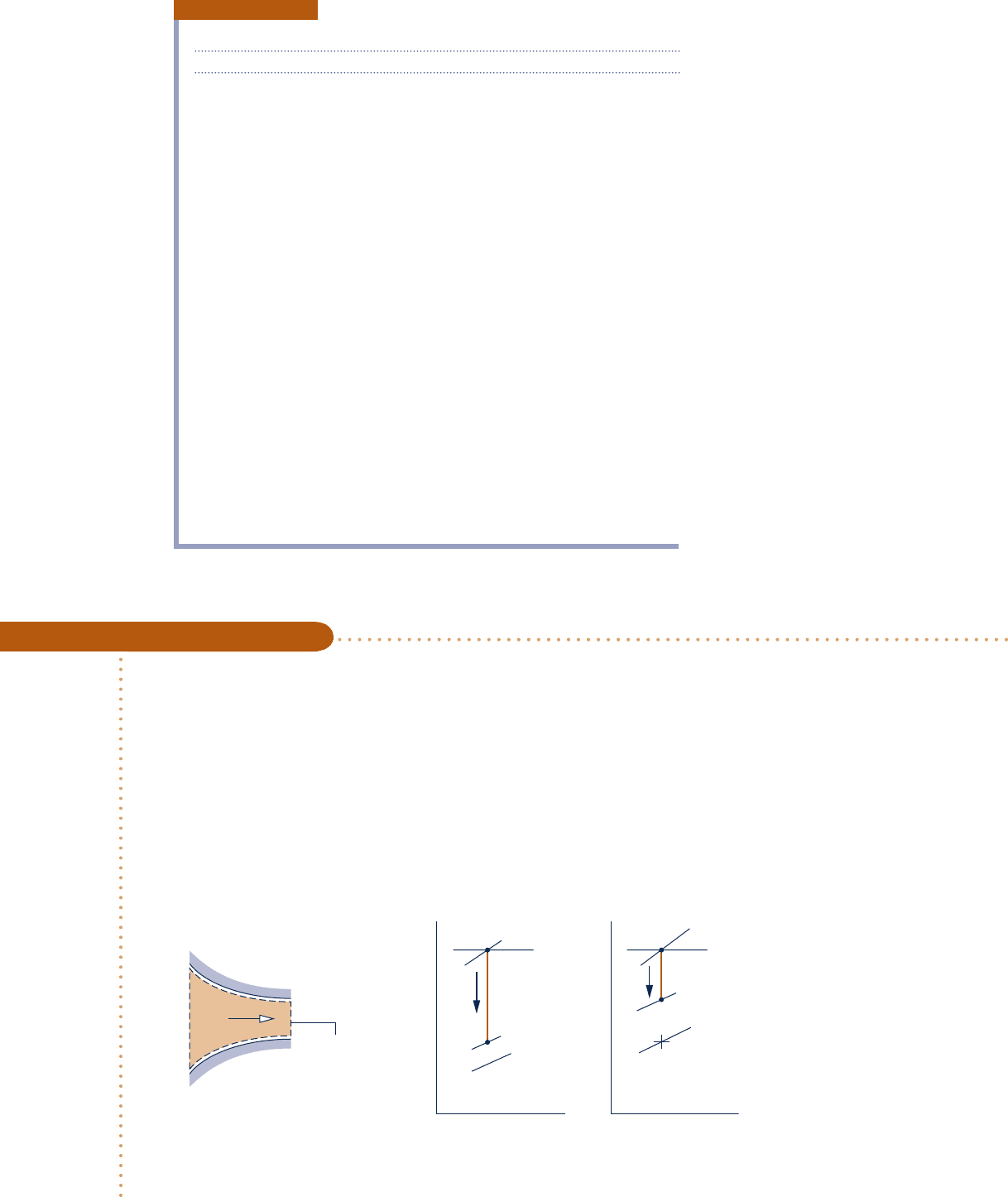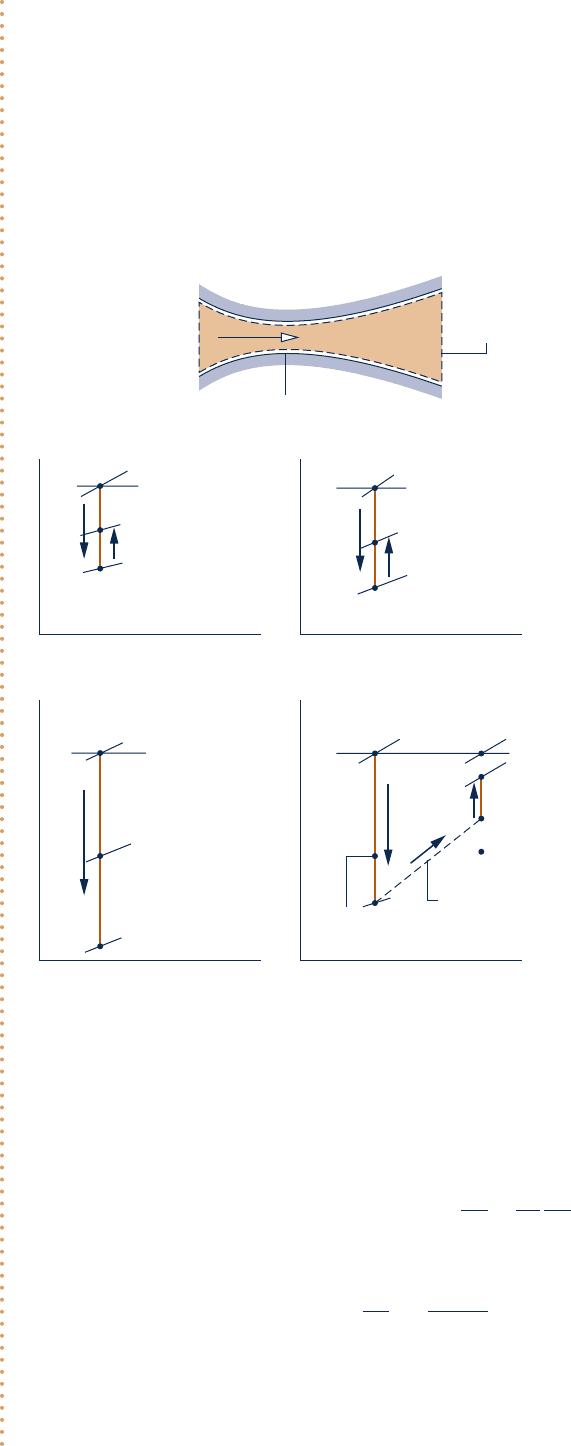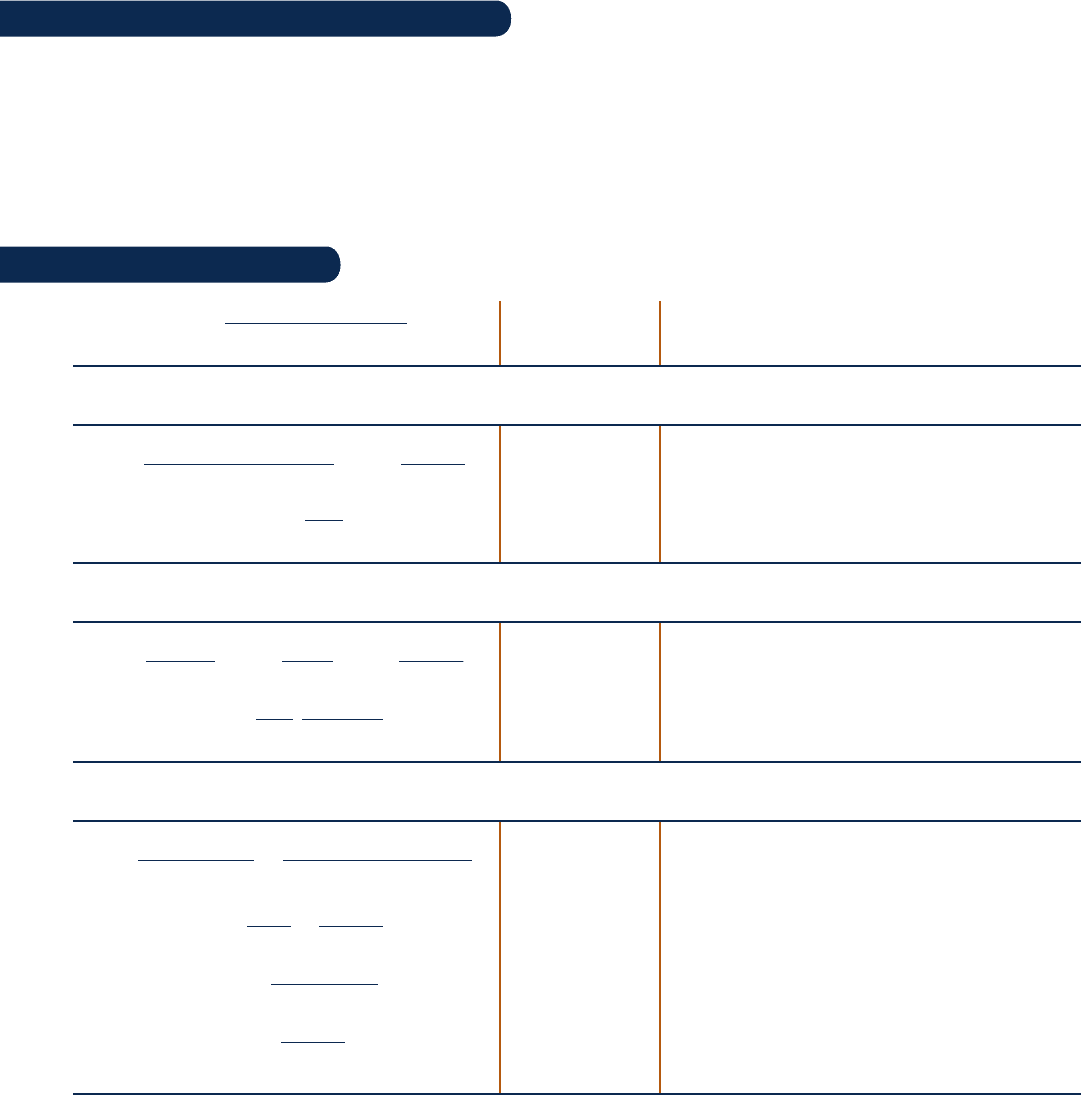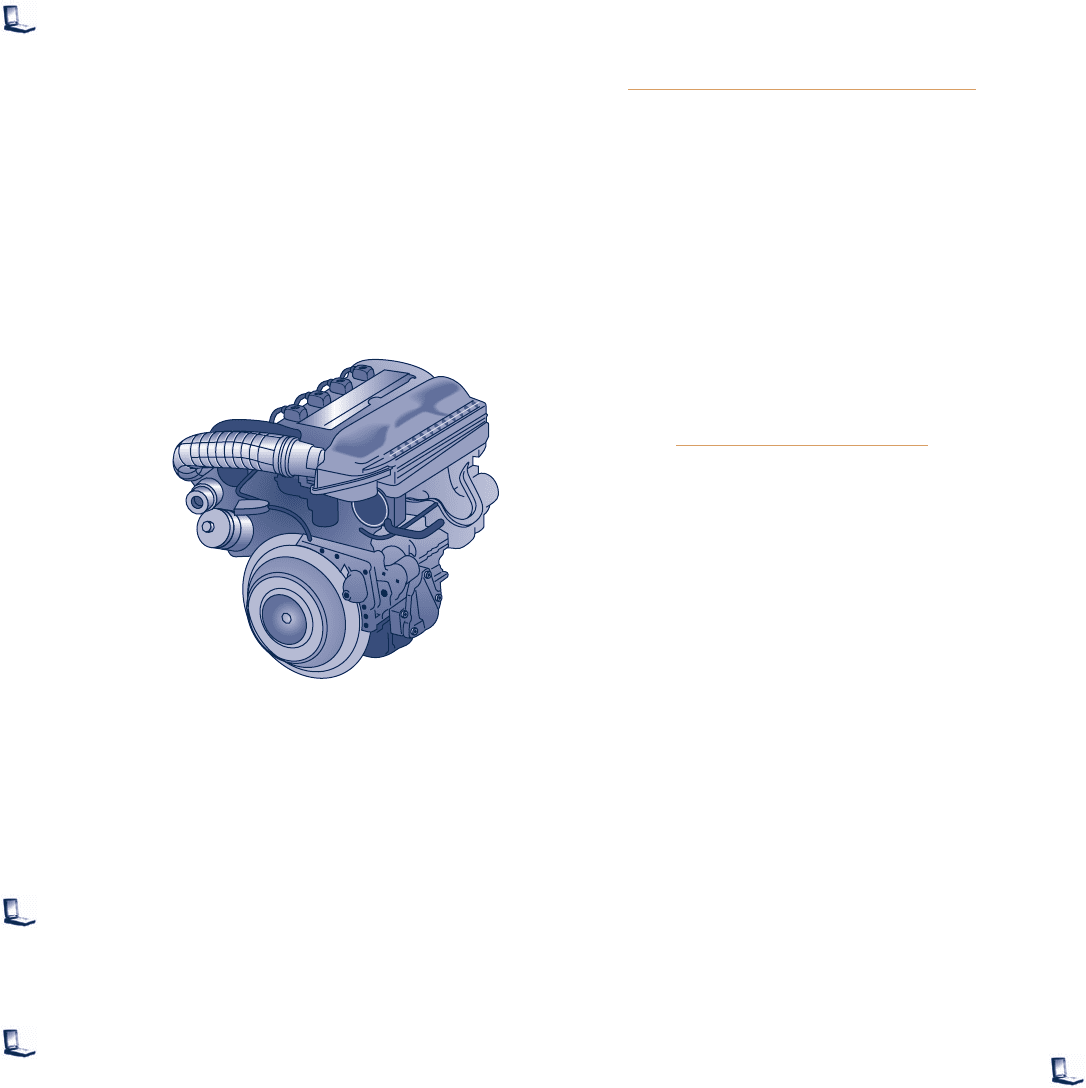Moran M.J., Shapiro H.N. Fundamentals of Engineering Thermodynamics
Подождите немного. Документ загружается.


In Example 9.14, we consider the effect of back pressure on flow in a converging
nozzle. The first step of the analysis is to check whether the flow is choked.
Isentropic Flow Functions for an Ideal Gas with k 5 1.4
M T/T
o
p/p
o
A/A*
0 1.000 00 1.000 00 `
0.10 0.998 00 0.993 03 5.8218
0.20 0.992 06 0.972 50 2.9635
0.30 0.982 32 0.939 47 2.0351
0.40 0.968 99 0.895 62 1.5901
0.50 0.952 38 0.843 02 1.3398
0.60 0.932 84 0.784 00 1.1882
0.70 0.910 75 0.720 92 1.094 37
0.80 0.886 52 0.656 02 1.038 23
0.90 0.860 58 0.591 26 1.008 86
1.00 0.833 33 0.528 28 1.000 00
1.10 0.805 15 0.468 35 1.007 93
1.20 0.776 40 0.412 38 1.030 44
1.30 0.747 38 0.360 92 1.066 31
1.40 0.718 39 0.314 24 1.1149
1.50 0.689 65 0.272 40 1.1762
1.60 0.661 38 0.235 27 1.2502
1.70 0.633 72 0.202 59 1.3376
1.80 0.606 80 0.174 04 1.4390
1.90 0.580 72 0.149 24 1.5552
2.00 0.555 56 0.127 80 1.6875
2.10 0.531 35 0.109 35 1.8369
2.20 0.508 13 0.093 52 2.0050
2.30 0.485 91 0.079 97 2.1931
2.40 0.464 68 0.068 40 2.4031
TABLE 9.2
9.14 Flow in Nozzles and Diffusers of Ideal Gases with Constant Specific Heats 563
Determining the Effect of Back Pressure: Converging Nozzle
c c c c EXAMPLE 9.14 c
A converging nozzle has an exit area of 0.001 m
2
. Air enters the nozzle with negligible velocity at a pressure of
1.0 MPa and a temperature of 360 K. For isentropic flow of an ideal gas with k 5 1.4, determine the mass flow
rate, in kg/s, and the exit Mach number for back pressures of (a) 500 kPa and (b) 784 kPa.
SOLUTION
Known:
Air flows isentropically from specified stagnation conditions through a converging nozzle with a known
exit area.
Find: For back pressures of 500 and 784 kPa, determine the mass flow rate, in kg/s, and the exit Mach number.
Schematic and Given Data:
Fig. E9.14
V
1
≈ 0
1
2
T
1
= T
o
= 360 K
p
1
= p
o
= 1.0 MPa
A
2
= 0.001 m
2
T
s
p
o
T
o
p
B
= 500 kPa
p
2
= p* = 528 kPa
1
2
T
s
p
o
T
o
p* = 528 kPa
p
B
= p
2
=
784 kPa
1
2
c09GasPowerSystems.indd Page 563 7/19/10 10:27:59 AM users-133 c09GasPowerSystems.indd Page 563 7/19/10 10:27:59 AM users-133 /Users/users-133/Desktop/Ramakant_04.05.09/WB00113_R1:JWCL170/New/Users/users-133/Desktop/Ramakant_04.05.09/WB00113_R1:JWCL170/New

564 Chapter 9
Gas Power Systems
Engineering Model:
1.
The control volume shown in the accompanying sketch operates at steady state.
2. The air is modeled as an ideal gas with k 5 1.4.
3. Flow through the nozzle is isentropic.
Analysis: The first step is to check whether the flow is choked. With k 5 1.4 and M 5 1.0, Eq. 9.51 gives
p*/p
o
5 0.528. Since p
o
5 1.0 MPa, the critical pressure is p* 5 528 kPa. Thus, for back pressures of 528 kPa
or less, the Mach number is unity at the exit and the nozzle is choked.
(a) From the above discussion, it follows that for a back pressure of 500 kPa, the nozzle is choked. At the exit,
M
2
5 1.0 and the exit pressure equals the critical pressure, p
2
5 528 kPa. The mass flow rate is the maximum
value that can be attained for the given stagnation properties. With the ideal gas equation of state, the mass flow
rate is
m
#
5 r
2
A
2
V
2
5
p
2
RT
2
A
2
V
2
The exit area A
2
required by this expression is specified as 10
23
m
2
. Since M 5 1 at the exit, the exit temperature
T
2
can be found from Eq. 9.50, which on rearrangement gives
T
2
5
T
o
1 1
k 2 1
2
M
2
5
360 K
1 1
a
1.4 2 1
2
b
112
2
5 300 K
Then, with Eq. 9.37, the exit velocity V
2
is
V
2
5
2
kRT
2
5
B
1.4 a
8314
28.97
N ? m
k
g
? K
b1300 K2`
1 kg ? m
/
s
2
1 N
`5 347.2 m
/
s
Finally
m
#
5
1528 3 10
3
N
/
m
2
2110
23
m
2
21347.2 m
/
s2
a
831
4
28.97
N ? m
kg ? K
b1300 K2
5 2.13 Kg
/
s
(b) Since the back pressure of 784 kPa is greater than the critical pressure determined above, the flow through-
out the nozzle is subsonic and the exit pressure equals the back pressure, p
2
5 784 kPa. The exit Mach number
can be found by solving Eq. 9.51 to obtain
M
2
5
e
2
k 2 1
ca
p
o
p
2
b
1
k21
2
y
k
2 1
df
1
y
2
Inserting values
M
2
5 e
2
1.4 2 1
ca
1 3 10
6
7.84 3 10
5
b
0.286
2 1 df
1
/
2
5 0.6
With the exit Mach number known, the exit temperature T
2
can be found
from Eq. 9.50 as 336 K. The exit velocity is then
V
2
5 M
2
c
2
5 M
2
2kRT
2
5 0.6
B
1.4
a
8314
28.97
b
13362
5 22
0.5
m
/
s
The mass flow rate is
m
#
5 r
2
A
2
V
2
5
p
2
RT
2
A
2
V
2
5
1784 3 10
3
2110
23
21220.52
1
8314
/
28.97
21
336
2
5 1.79 kg
/
s
Ability to…
❑
apply the ideal gas model
with constant k in the
analysis of isentropic flow
through a converging nozzle.
❑
understand when choked flow
occurs in a converging nozzle
for different back pressures.
❑
determine conditions at the
throat and the mass flow
rate for different back
pressures and a fixed
stagnation state.
✓
Skills Developed
➊
c09GasPowerSystems.indd Page 564 7/19/10 10:27:59 AM users-133 c09GasPowerSystems.indd Page 564 7/19/10 10:27:59 AM users-133 /Users/users-133/Desktop/Ramakant_04.05.09/WB00113_R1:JWCL170/New/Users/users-133/Desktop/Ramakant_04.05.09/WB00113_R1:JWCL170/New

9.14.2
Normal Shock Functions
Next, let us develop closed-form equations for normal shocks for the case of an ideal gas
with constant specific heats. For this case, it follows from the energy equation, Eq. 9.47b,
that there is no change in stagnation temperature across the shock, T
ox
5 T
oy
. Then, with
Eq. 9.50, the following expression for the ratio of temperatures across the shock is
obtained
T
y
T
x
5
1 1
k 2 1
2
M
2
x
1 1
k 2 1
2
M
2
y
(9.53)
Rearranging Eq. 9.48
p
x
1 r
x
V
2
x
5 p
y
1 r
y
V
2
y
Introducing the ideal gas equation of state, together with Eqs. 9.37 and 9.38, the ratio
of the pressure downstream of the shock to the pressure upstream is
p
y
p
x
5
1 1 kM
2
x
1 1 kM
2
y
(9.54)
Similarly, Eq. 9.46 becomes
p
y
p
x
5
B
T
y
T
x
M
x
M
y
The following equation relating the Mach numbers
M
x
and
M
y
across the shock can
be obtained when Eqs. 9.53 and 9.54 are introduced in this expression
M
2
y
5
M
2
x
1
2
k 2 1
2k
k
2 1
M
2
x
2 1
(9.55)
The ratio of stagnation pressures across a shock p
oy
/p
ox
is often useful. It is left as
an exercise to show that
p
oy
p
ox
5
M
x
M
y
±
1 1
k 2 1
2
M
2
y
1 1
k 2
1
2
M
2
x
≤
1k112
/
21k212
(9.56)
Using the isentropic flow functions in Table 9.2, determine the
exit temperature and Mach number for a back pressure of 843 kPa.
Ans. 342.9 K, 0.5.
➊ The use of Table 9.2 reduces some of the computation required in the solution. It is left as an exercise to
develop a solution using this table. Also, observe that the first step of the analysis is to check whether the
flow is choked.
9.14 Flow in Nozzles and Diffusers of Ideal Gases with Constant Specific Heats 565
c09GasPowerSystems.indd Page 565 7/19/10 10:28:01 AM users-133 c09GasPowerSystems.indd Page 565 7/19/10 10:28:01 AM users-133 /Users/users-133/Desktop/Ramakant_04.05.09/WB00113_R1:JWCL170/New/Users/users-133/Desktop/Ramakant_04.05.09/WB00113_R1:JWCL170/New

566 Chapter 9 Gas Power Systems
Since there is no area change across a shock, Eqs. 9.52 and 9.56 combine to give
A
*
x
A
*
y
5
p
oy
p
ox
(9.57)
For specified values of M
x
and specific heat ratio k, the Mach number downstream
of a shock can be found from Eq. 9.55. Then, with M
x
, M
y
, and k known, the ratios
T
y
/T
x
, p
y
/p
x
, and p
oy
/p
ox
can be determined from Eqs. 9.53, 9.54, and 9.56. Accordingly,
tables can be set up giving M
y
, T
y
/T
x
, p
y
/p
x
, and p
oy
/p
ox
versus the Mach number M
x
as the single independent variable for a specified value of k. Table 9.3 is a tabulation
of this kind for k 5 1.4.
In the next example, we consider the effect of back pressure on flow in a converging–
diverging nozzle. Key elements of the analysis include determining whether the flow
is choked and if a normal shock exists.
Normal Shock Functions for an Ideal Gas with k 5 1.4
M
x
M
y
p
y
/p
x
T
y
/T
x
p
oy
/p
ox
1.00 1.000 00 1.0000 1.0000 1.000 00
1.10 0.911 77 1.2450 1.0649 0.998 92
1.20 0.842 17 1.5133 1.1280 0.992 80
1.30 0.785 96 1.8050 1.1909 0.979 35
1.40 0.739 71 2.1200 1.2547 0.958 19
1.50 0.701 09 2.4583 1.3202 0.929 78
1.60 0.668 44 2.8201 1.3880 0.895 20
1.70 0.640 55 3.2050 1.4583 0.855 73
1.80 0.616 50 3.6133 1.5316 0.812 68
1.90 0.595 62 4.0450 1.6079 0.767 35
2.00 0.577 35 4.5000 1.6875 0.720 88
2.10 0.561 28 4.9784 1.7704 0.674 22
2.20 0.547 06 5.4800 1.8569 0.628 12
2.30 0.534 41 6.0050 1.9468 0.583 31
2.40 0.523 12 6.5533 2.0403 0.540 15
2.50 0.512 99 7.1250 2.1375 0.499 02
2.60 0.503 87 7.7200 2.2383 0.460 12
2.70 0.495 63 8.3383 2.3429 0.423 59
2.80 0.488 17 8.9800 2.4512 0.389 46
2.90 0.481 38 9.6450 2.5632 0.357 73
3.00 0.475 19 10.333 2.6790 0.328 34
4.00 0.434 96 18.500 4.0469 0.138 76
5.00 0.415 23 29.000 5.8000 0.061 72
10.00 0.387 57 116.50 20.388 0.003 04
` 0.377 96 ` ` 0.0
TABLE 9.3
Determining the Effect of Back Pressure: Converging–Diverging Nozzle
c c c c EXAMPLE 9.15 c
A converging–diverging nozzle operating at steady state has a throat area of 1.0 in.
2
and an exit area of 2.4 in.
2
Air enters the nozzle with a negligible velocity at a pressure of 100 lbf/in.
2
and a temperature of 500°R. For air
as an ideal gas with k 5 1.4, determine the mass flow rate, in lb/s, the exit pressure, in lbf/in.
2
, and exit Mach
number for each of the five following cases. (a) Isentropic flow with M 5 0.7 at the throat. (b) Isentropic
flow with M 5 1 at the throat and the diverging portion acting as a diffuser. (c) Isentropic flow with M 5 1 at
the throat and the diverging portion acting as a nozzle. (d) Isentropic flow through the nozzle with a normal
➊
c09GasPowerSystems.indd Page 566 7/19/10 10:28:02 AM users-133 c09GasPowerSystems.indd Page 566 7/19/10 10:28:02 AM users-133 /Users/users-133/Desktop/Ramakant_04.05.09/WB00113_R1:JWCL170/New/Users/users-133/Desktop/Ramakant_04.05.09/WB00113_R1:JWCL170/New

shock standing at the exit. (e) A normal shock stands in the diverging section at a location where the area is 2.0 in.
2
Elsewhere in the nozzle, the flow is isentropic.
SOLUTION
Known:
Air flows from specified stagnation conditions through a converging–diverging nozzle having a known
throat and exit area.
Find: The mass flow rate, exit pressure, and exit Mach number are to be determined for each of five cases.
Schematic and Given Data:
Analysis:
(a)
The accompanying T–s diagram shows the states visited by the gas in this case. The following are known:
the Mach number at the throat, M
t
5 0.7, the throat area, A
t
5 1.0 in.
2
, and the exit area, A
2
5 2.4 in.
2
The exit
Mach number M
2
, exit temperature T
2
, and exit pressure p
2
can be determined using the identity
A
2
A*
5
A
2
A
t
A
t
A*
With M
t
5 0.7, Table 9.2 gives A
t
/A* 5 1.09437. Thus
A
2
A*
5 a
2.4 in.
2
1.0 in.
2
b 11.0943725 2.6265
9.14 Flow in Nozzles and Diffusers of Ideal Gases with Constant Specific Heats 567
Engineering Model:
1.
The control volume shown in the accompa-
nying sketch operates at steady state. The
T–s diagrams provided locate states within
the nozzle.
2. The air is modeled as an ideal gas with
k 5 1.4.
3. Flow through the nozzle is isentropic
throughout, except for case (e), where a
shock stands in the diverging section.
Fig. E9.15
V
1
≈ 0
p
1
= p
o
= 100 lbf/in.
2
T
1
= T
o
= 500°R
1
2
A
t
= 1.0 in.
2
A
2
= 2.4 in.
2
T
s
p
o
= 100 lbf/in.
2
p
2
= 95.9 lbf/in.
2
p
t
M
t
= 0.7
T
o
= 500°R
1
2
Case (a
)
T
s
p
o
= 100 lbf/in.
2
p
2
= 95.3 lbf/in.
2
p
t
= p*
M
t
= 1
T
o
= 500°R
1
2
Case (b
)
T
s
p
o
= 100 lbf/in.
2
p
2
= 6.84 lbf/in.
2
p
t
= p*
p
ox
p
oy
p
2
M
t
= 1
T
o
= 500°R
1
2
Cases (c) and (d
)
T
s
2
1
Case (e
)
Sonic state
associated
with state x
Sonic state
associated
with state y
Normal shock
Stagnation state
associated with
state x
Stagnation state
associated with
state y
x
y
c09GasPowerSystems.indd Page 567 7/19/10 10:28:03 AM users-133 c09GasPowerSystems.indd Page 567 7/19/10 10:28:03 AM users-133 /Users/users-133/Desktop/Ramakant_04.05.09/WB00113_R1:JWCL170/New/Users/users-133/Desktop/Ramakant_04.05.09/WB00113_R1:JWCL170/New

568 Chapter 9 Gas Power Systems
The flow throughout the nozzle, including the exit, is subsonic. Accordingly, with this value for A
2
/A*, Table 9.2
gives M
2
< 0.24. For M
2
5 0.24, T
2
/T
o
5 0.988, and p
2
/p
o
5 0.959. Since the stagnation temperature and pressure
are 500°R and 100 lbf/in.
2
, respectively, it follows that T
2
5 494°R and p
2
5 95.9 lbf/in.
2
The velocity at the exit is
V
2
5 M
2
c
2
5 M
2
2
kRT
2
5 0.24
B
1.4 a
1545
28.97
ft ? lbf
lb ? 8R
b 14948R2`
32.2 lb ? ft
/
s
2
1 lbf
`
5 2
6
2 f
t
/
s
The mass flow rate is
m
#
5 r
2
A
2
V
2
5
p
2
RT
2
A
2
V
2
5
195.9 lbf
/
in.
2
212.4 in.
2
21262 ft
/
s2
a
1545
2
8.97
ft ? lbf
l
b
? 8R
b
14948R2
5 2.29 lb
/
s
(b) The accompanying T–s diagram shows the states visited by the gas in this case. Since M 5 1 at the throat,
we have A
t
5 A*, and thus A
2
/A* 5 2.4. Table 9.2 gives two Mach numbers for this ratio: M <
0.
2
6
and M < 2
.
4
.
The diverging portion acts as a diffuser in the present part of the example; accordingly, the subsonic value is
appropriate. The supersonic value is appropriate in part (c).
Thus, from Table 9.2 we have at M
2
5 0.26, T
2
/T
o
5 0.986, and p
2
/p
o
5 0.953. Since T
o
5 500°R and p
o
5
100 lbf/in.
2
, it follows that T
2
5 493°R and p
2
5 95.3 lbf/in.
2
The velocity at the exit is
V
2
5 M
2
c
2
5 M
2 1kRT
2
5 0.26
B
11.42 a
1545
28.97
b 14932
Z
32.2
Z
5 283 ft
/
s
The mass flow rate is
m
#
5
p
2
RT
2
A
2
V
2
5
195.3212.421283
2
a
1545
28.97
b14932
5 2.46 lb
/
s
This is the maximum mass flow rate for the specified geometry and stagnation conditions: the flow is
choked.
(c) The accompanying T–s diagram shows the states visited by the gas in this case. As discussed in part (b), the
exit Mach number in the present part of the example is M
2
5 2.4. Using this, Table 9.2 gives p
2
/p
0
5 0.0684.
With p
o
5 100 lbf/in.
2
, the pressure at the exit is p
2
5 6.84 lbf/in.
2
Since the nozzle is choked, the mass flow rate
is the same as found in part (b).
(d) Since a normal shock stands at the exit and the flow upstream of the shock is isentropic, the Mach number M
x
and the pressure p
x
correspond to the values found in part (c), M
x
5 2.4, p
x
5 6.84 lbf/in.
2
Then, from Table 9.3,
M
y
< 0.52 and p
y
/p
x
5 6.5533. The pressure downstream of the shock is thus 44.82 lbf/in.
2
This is the exit pressure.
The mass flow is the same as found in part (b).
(e) The accompanying T–s diagram shows the states visited by the gas. It is known that a shock stands in the
diverging portion where the area is A
x
5 2.0 in.
2
Since a shock occurs, the flow is sonic at the throat, so
A
x
* 5 A
t
5 1.0 in.
2
The Mach number M
x
can then be found from Table 9.2, by using A
x
/
A*
x
5 2, as M
x
5 2.2.
The Mach number at the exit can be determined using the identity
A
2
A*
y
5 a
A
2
A*
x
ba
A*
x
A*
y
b
c09GasPowerSystems.indd Page 568 7/19/10 10:28:05 AM users-133 c09GasPowerSystems.indd Page 568 7/19/10 10:28:05 AM users-133 /Users/users-133/Desktop/Ramakant_04.05.09/WB00113_R1:JWCL170/New/Users/users-133/Desktop/Ramakant_04.05.09/WB00113_R1:JWCL170/New

Introducing Eq. 9.57 to replace A*
x
/
A*
y
, this becomes
A
2
A*
y
5 a
A
2
A*
x
ba
p
oy
p
ox
b
where p
ox
and p
oy
are the stagnation pressures before and after the shock, respec-
tively. With M
x
5 2.2, the ratio of stagnation pressures is obtained from Table
9.3 as p
oy
/p
ox
5 0.62812. Thus
A
2
A*
y
5 a
2.4 in.
2
1.0 in.
2
b10.6281225 1.51
Using this ratio and noting that the flow is subsonic after the shock, Table 9.2 gives
M
2
<
0
.
43
, for which p
2
/p
oy
5 0.88.
The pressure at the exit can be determined using the identity
p
2
5 a
p
2
p
oy
b a
p
oy
p
ox
b p
ox
5 10.88210.6282 a100
lbf
in.
2
b5 55.3 lbf
/
in.
2
Since the flow is choked, the mass flow rate is the same as that found in part (b).
➊ With reference to cases labeled on Fig. 9.32, part (a) of the present exam-
ple corresponds to case c on the figure, part (b) corresponds to case d, part
(c) corresponds to case i, part (d) corresponds to case g, and part (e) cor-
responds to case f.
Ability to…
❑
analyze isentropic flow
through a converging–
diverging nozzle for an ideal
gas with constant k.
❑
understand the occurrence
of choked flow and normal
shocks in a converging–
diverging nozzle for different
back pressures.
❑
analyze the flow through a
converging–diverging nozzle
when normal shocks are
present for an ideal gas with
constant k.
✓
Skills Developed
What is the stagnation temperature, in 8R, corresponding to
the exit state for case (e)? Ans. 500°R.
In this chapter, we have studied the thermodynamic modeling of
internal combustion engines, gas turbine power plants, and com-
pressible flow in nozzles and diffusers. The modeling of cycles is
based on the use of air-standard analysis, where the working
fluid is considered to be air as an ideal gas.
The processes in internal combustion engines are described
in terms of three air-standard cycles: the Otto, Diesel, and dual
cycles, which differ from each other only in the way the heat
addition process is modeled. For these cycles, we have evaluated
the principal work and heat transfers along with two important
performance parameters: the mean effective pressure and the
thermal efficiency. The effect of varying compression ratio on
cycle performance is also investigated.
The performance of simple gas turbine power plants is
described in terms of the air-standard Brayton cycle. For this
cycle, we evaluate the principal work and heat transfers along
with two important performance parameters: the back work ratio
and the thermal efficiency. We also consider the effects on per-
formance of irreversibilities and of varying compressor pressure
ratio. Three modifications of the simple cycle to improve perfor-
mance are introduced: regeneration, reheat, and compression
with intercooling. Applications related to gas turbines are also
considered, including combined gas turbine–vapor power cycles,
integrated gasification combined-cycle (IGCC) power plants, and
gas turbines for aircraft propulsion. In addition, the Ericsson and
Stirling cycles are introduced.
The chapter concludes with the study of compressible flow
through nozzles and diffusers. We begin by introducing the
momentum equation for steady, one-dimensional flow, the veloc-
ity of sound, and the stagnation state. We then consider the
effects of area change and back pressure on performance in both
subsonic and supersonic flows. Choked flow and the presence of
normal shocks in such flows are investigated. Tables are intro-
duced to facilitate analysis for the case of ideal gases with con-
stant specific heat ratio, k 5 1.4.
The following list provides a study guide for this chapter.
When your study of the text and end-of-chapter exercises has
been completed, you should be able to
c
write out the meanings of the terms listed in the margin
throughout the chapter and understand each of the related
concepts. The subset of key concepts listed on p. 570 is particu-
larly important.
c
sketch p–y and T–s diagrams of the Otto, Diesel, and dual
cycles. Apply the closed system energy balance and the sec-
ond law along with property data to determine the perfor-
mance of these cycles, including mean effective pressure, ther-
mal efficiency, and the effects of varying compression ratio.
c CHAPTER SUMMARY AND STUDY GUIDE
Chapter Summary and Study Guide 569
c09GasPowerSystems.indd Page 569 7/19/10 10:28:08 AM users-133 c09GasPowerSystems.indd Page 569 7/19/10 10:28:08 AM users-133 /Users/users-133/Desktop/Ramakant_04.05.09/WB00113_R1:JWCL170/New/Users/users-133/Desktop/Ramakant_04.05.09/WB00113_R1:JWCL170/New

570 Chapter 9 Gas Power Systems
c
sketch schematic diagrams and accompanying T–s diagrams of
the Brayton cycle and modifications involving regeneration,
reheat, and compression with intercooling. In each case, be
able to apply mass and energy balances, the second law, and
property data to determine gas turbine power cycle perfor-
mance, including thermal efficiency, back work ratio, net power
output, and the effects of varying compressor pressure ratio.
c
analyze the performance of gas turbine–related applications
involving combined gas turbine–vapor power plants, IGCC
power plants, and aircraft propulsion. You also should be able
to apply the principles of this chapter to Ericsson and Stirling
cycles.
c
discuss for nozzles and diffusers the effects of area change in
subsonic and supersonic flows, the effects of back pressure
on mass flow rate, and the appearance and consequences of
choking and normal shocks.
c
analyze the flow in nozzles and diffusers of ideal gases with
constant specific heats, as in Examples 9.14 and 9.15.
c KEY ENGINEERING CONCEPTS
mean effective pressure, p. 495
air-standard analysis, p. 495
Otto cycle, p. 497
Diesel cycle, p. 502
dual cycle, p. 506
Brayton cycle, p. 511
regenerator, p. 521
regenerator effectiveness, p. 523
reheat, p. 526
intercooler, p. 528
combined cycle, pp. 537, 544
turbojet engine, p. 546
compressible flow, p. 550
momentum equation, p. 552
velocity of sound, p. 553
Mach number, p. 554
subsonic and supersonic flow, p. 554
stagnation state, p. 555
choked flow, p. 559
normal shock, p. 559
c KEY EQUATIONS
mep 5
net work for one cycl
e
displacement volume
(9.1) p. 495
Mean effective pressure for reciprocating
piston engines
Otto Cycle
h 5
1
u
3
2 u
2
2
2
1
u
4
2 u
1
2
u
3
2 u
2
5 1 2
u
4
2 u
1
u
3
2 u
2
(9.3) p. 498
Thermal efficiency (Figure 9.3)
h 5 1 2
1
r
k21
(9.8) p. 499
Thermal efficiency (cold-air standard basis)
Diesel Cycle
h 5
W
cycle
/
m
Q
2
3
/
m
5 1 2
Q
41
/
m
Q
2
3
/
m
5 1 2
u
4
2 u
1
h
3
2 h
2
(9.11) p. 503
Thermal efficiency (Figure 9.5)
h 5 1 2
1
r
k21
c
r
k
c
2 1
k
1
r
c
2 1
2
d
(9.13) p. 503
Thermal efficiency (cold-air standard basis)
Brayton Cycle
h 5
W
#
t
/
m
#
2 W
#
c
/
m
#
Q
#
in
/
m
#
5
1h
3
2 h
4
22 1h
2
2 h
1
2
h
3
2 h
2
(9.19) p. 512
Thermal efficiency (Figure 9.9)
bwr 5
W
#
c
/
m
#
W
#
t
/
m
#
5
h
2
2 h
1
h
3
2 h
4
(9.20) p. 512
Back work ratio (Figure 9.9)
h 5 1 2
1
1p
2
/
p
1
2
1k212
/
k
(9.25) p. 516
Thermal efficiency (cold-air standard basis)
h
reg
5
h
x
2 h
2
h
4
2 h
2
(9.27) p. 523
Regenerator effectiveness for the regenerative
gas turbine cycle (Figure 9.14)
c09GasPowerSystems.indd Page 570 7/19/10 2:03:04 PM users-133 c09GasPowerSystems.indd Page 570 7/19/10 2:03:04 PM users-133 /Users/users-133/Desktop/Ramakant_04.05.09/WB00113_R1:JWCL170/New/Users/users-133/Desktop/Ramakant_04.05.09/WB00113_R1:JWCL170/New

Compressible Flow in Nozzles and Diffusers
F 5 m
#
1
V
2
2 V
1
2
(9.31) p. 552 Momentum equation for steady-state
one-dimensional flow
c
5
2k
RT (9.37) p. 554 Ideal gas velocity of sound
M 5
V
/
c
(9.38) p. 554 Mach number
h
o
5 h 1 V
2
/
2 (9.39) p. 555 Stagnation enthalpy
T
o
T
5 1 1
k 2 1
2
M
2
(9.50) p. 562
Isentropic flow function relating temperature
and stagnation temperature (constant k)
p
o
p
5
a
T
o
T
b
k
/
1
k21
2
5
a
1 1
k 2 1
2
M
2
b
k
/
1
k21
2
(9.51) p. 562
Isentropic flow function relating pressure and
stagnation pressure (constant k)
c EXERCISES: THINGS ENGINEERS THINK ABOUT
1. Diesel engines are said to produce higher torque than
gasoline engines. What does that mean?
2. Formula One race cars have 2.4 liter engines. What does
that signify? How is your car’s engine sized in liters?
3. The ideal Brayton and Rankine cycles are composed of the
same four processes, yet look different when represented on
a T–s diagram. Explain.
4. The term regeneration is used to describe the use of
regenerative feedwater heaters in vapor power plants and
regenerative heat exchangers in gas turbines. In what ways are
the purposes of these devices similar? How do they differ?
5. You jump off a raft into the water in the middle of a lake.
What direction does the raft move? Explain.
6. What is the purpose of a rear diffuser on a race car?
7. What is the meaning of the octane rating that you see posted
on gas pumps? Why is it important to consumers?
8. Why aren’t jet engines of airliners fitted with screens to
avoid birds being pulled into the intake?
9. When did the main power plant providing electricity to your
residence begin generating power? How long is it expected
to continue operating?
10. What is the purpose of the gas turbine–powered auxiliary
power units commonly seen at airports near commercial
aircraft?
11. A nine-year-old camper is suddenly awakened by a
metallic click coming from the direction of a railroad track
passing close to her camping area; soon afterward, she
hears the deep growling of a diesel locomotive pulling an
approaching train. How would you interpret these different
sounds to her?
12. Automakers have developed prototype gas turbine–
powered vehicles, but the vehicles have not been generally
marketed to consumers. Why?
13. In making a quick stop at a friend’s home, is it better to
let your car’s engine idle or turn it off and restart when you
leave?
14. How do today’s more effective diesel engine exhaust
treatment systems work?
15. What is the range of fuel efficiencies, in miles per gallon,
you get with you car? At what speeds, in miles per hour, is
the peak achieved?
16. Where is Marcellus shale and why is it significant?
17. Does your state regulate the practice of venting high-
pressure natural gas to clean debris from pipelines leading
to power plant gas turbines? What hazards are associated
with this practice?
c PROBLEMS: DEVELOPING ENGINEERING SKILLS
Otto, Diesel, and Dual Cycles
9.1 An air-standard Otto cycle has a compression ratio of 9. At
the beginning of compression, p
1
5 100 kPa and T
1
5 300 K.
The heat addition per unit mass of air is 1350 kJ/kg.
Determine
(a) the net work, in kJ per kg of air.
(b) the thermal efficiency of the cycle.
(c) the mean effective pressure, in kPa.
(d) the maximum temperature in the cycle, in K.
(e) To investigate the effects of varying compression ratio,
plot each of the quantities calculated in parts (a) through
(d) for compression ratios ranging from 1 to 12.
9.2 Solve Problem 9.1 on a cold air-standard basis with specific
heats evaluated at 300 K.
9.3 At the beginning of the compression process of an air-
standard Otto cycle, p
1
5 1 bar, T
1
5 290 K, V
1
5 400 cm
3
.
Problems: Developing Engineering Skills 571
c09GasPowerSystems.indd Page 571 7/19/10 10:28:11 AM users-133 c09GasPowerSystems.indd Page 571 7/19/10 10:28:11 AM users-133 /Users/users-133/Desktop/Ramakant_04.05.09/WB00113_R1:JWCL170/New/Users/users-133/Desktop/Ramakant_04.05.09/WB00113_R1:JWCL170/New

572 Chapter 9
Gas Power Systems
The maximum temperature in the cycle is 2200 K and the
compression ratio is 8. Determine
(a) the heat addition, in kJ.
(b) the net work, in kJ.
(c) the thermal efficiency.
(d) the mean effective pressure, in bar.
(e) Develop a full accounting of the exergy transferred to
the air during the heat addition, in kJ.
(f) Devise and evaluate an exergetic efficiency for the cycle.
Let T
0
5 290 K, p
0
5 1 bar.
9.4 Plot each of the quantities specified in parts (a) through
(d) of Problem 9.3 versus the compression ratio ranging
from 2 to 12.
9.5 Solve Problem 9.3 on a cold air-standard basis with specific
heats evaluated at 300 K.
9.6 A four-cylinder, four-stroke internal combustion engine
operates at 2800 RPM. The processes within each cylinder
are modeled as an air-standard Otto cycle with a pressure of
14.7 lbf/in.
2
, a temperature of 808F, and a volume of 0.0196 ft
3
at the beginning of compression. The compression ratio is
10, and maximum pressure in the cycle is 1080 lbf/in.
2
Determine, using a cold air-standard analysis with k
5 1.4,
the power developed by the engine, in horsepower, and the
mean effective pressure, in lbf/in.
2
for maximum cycle temperatures ranging from 2000 to
50008R and compression ratios of 6, 8, and 10.
9.10 Solve Problem 9.9 on a cold air-standard basis using
k
5 1.4.
9.11 Consider an air-standard Otto cycle. Operating data at
principal states in the cycle are given in the table below. The
states are numbered as in Fig. 9.3. The mass of air is 0.002 kg.
Determine
(a) the heat addition and the heat rejection, each in kJ.
(b) the net work, in kJ.
(c) the thermal efficiency.
(d) the mean effective pressure, in kPa.
State T (K) p (kPa) u (kJ/kg)
1 305 85 217.67
2 367.4 767.9 486.77
3 960 2006 725.02
4 458.7 127.8 329.01
9.12 Consider a cold air-standard Otto cycle. Operating data
at principal states in the cycle are given in the table below.
The states are numbered as in Fig. 9.3. The heat rejection
from the cycle is 86 Btu per lb of air. Assuming c
y
5
0.172 Btu/lb ? 8R, determine
(a) the compression ratio.
(b) the net work per unit mass of air, in Btu/lb.
(c) the thermal efficiency.
(d) the mean effective pressure, in lbf/in.
2
State T (8R) p (lbf/in.
2
)
1 500 47.50
2 1204.1 1030
3 2408.2 2060
4 1000 95
9.13 Consider a modification of the air-standard Otto cycle in
which the isentropic compression and expansion processes
are each replaced with polytropic processes having n
5 1.3.
The compression ratio is 9 for the modified cycle. At the
beginning of compression, p
1
5 1 bar and T
1
5 300 K and
V
1
5 2270 cm
3
. The maximum temperature during the cycle
is 2000 K. Determine
(a) the heat transfer and work in kJ, for each process in the
modified cycle.
(b) the thermal efficiency.
(c) the mean effective pressure, in bar.
9.14 A four-cylinder, four-stroke internal combustion engine
has a bore of 2.55 in. and a stroke of 2.10 in. The clearance
volume is 12% of the cylinder volume at bottom dead center
and the crankshaft rotates at 3600 RPM. The processes
within each cylinder are modeled as an air-standard Otto
cycle with a pressure of 14.6 lbf/in.
2
and a temperature of
1008F at the beginning of compression. The maximum
temperature in the cycle is 52008R. Based on this model,
calculate the net work per cycle, in Btu, and the power
developed by the engine, in horsepower.
9.15 At the beginning of the compression process in an air-
standard Otto cycle, p
1
5 1 bar and T
1
5 300 K. The maximum
9.7 An air-standard Otto cycle has a compression ratio of 8
and the temperature and pressure at the beginning of the
compression process are 5208R and 14.2 lbf/in.
2
, respectively.
The mass of air is 0.0015 lb. The heat addition is 0.9 Btu.
Determine
(a) the maximum temperature, in 8R.
(b) the maximum pressure, in lbf/in.
2
(c) the thermal efficiency.
(d) To investigate the effects of varying compression ratio,
plot each of the quantities calculated in parts (a) through (c)
for compression ratios ranging from 2 to 12.
9.8 Solve Problem 9.7 on a cold air-standard basis with specific
heats evaluated at 5208R.
9.9 At the beginning of the compression process in an air-
standard Otto cycle, p
1
5 14.7 lbf/in.
2
and T
1
5 5308R. Plot
the thermal efficiency and mean effective pressure, in lbf/in.
2
,
Fig. P9.6
c09GasPowerSystems.indd Page 572 9/24/10 3:35:29 PM user-s146 c09GasPowerSystems.indd Page 572 9/24/10 3:35:29 PM user-s146 /Users/user-s146/Desktop/Merry_X-Mas/New/Users/user-s146/Desktop/Merry_X-Mas/New
